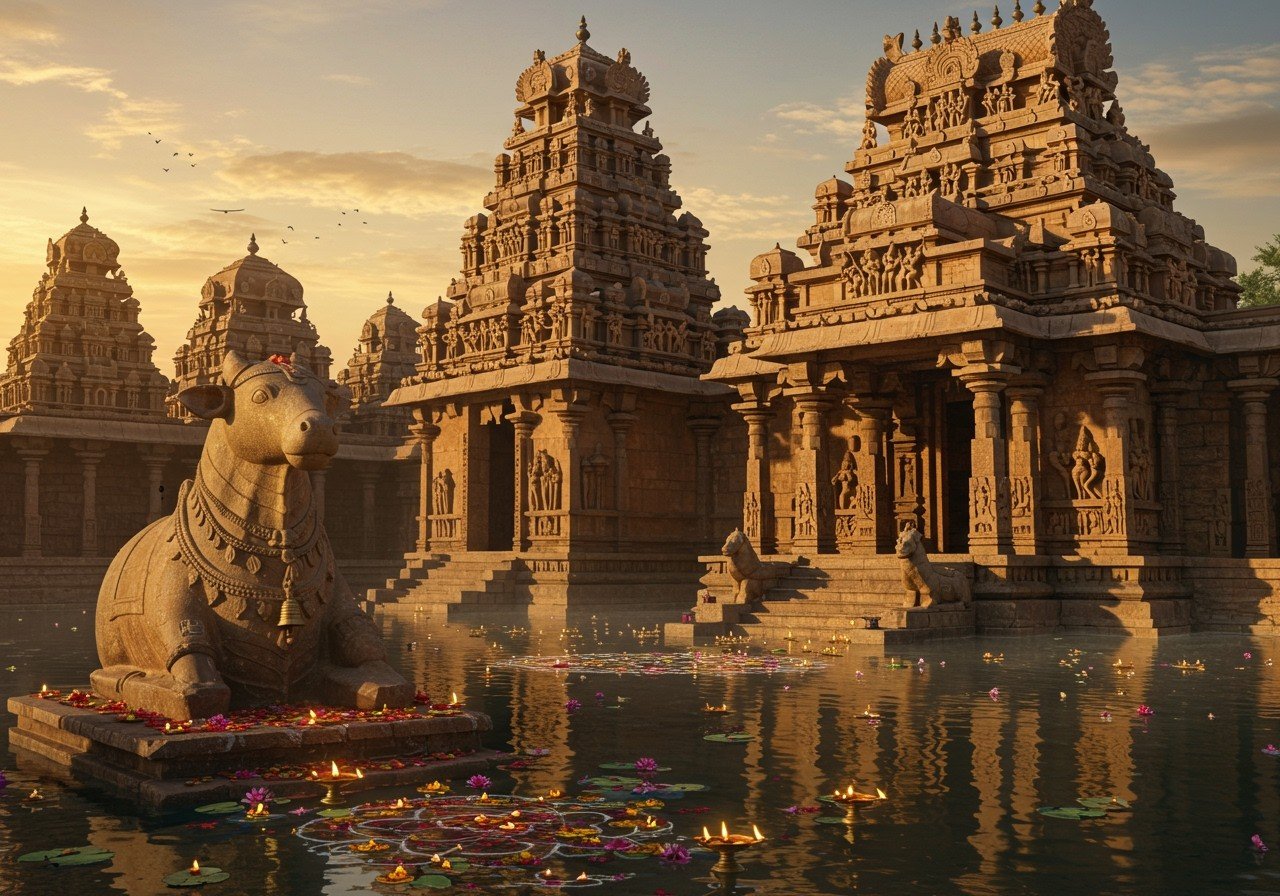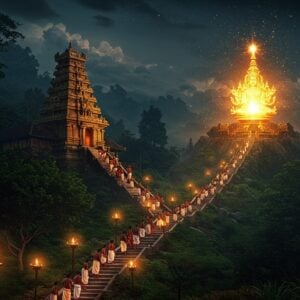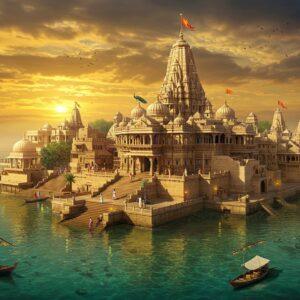
South Indian temples are more than just places of worship; they are a confluence of art, architecture, and deep spirituality. These magnificent structures stand as testaments to the rich cultural heritage of the region. Their intricate stone carvings and vibrant iconography, hallmarks of the Dravidian architectural style, whisper tales of centuries past. Photography offers a powerful medium to preserve and share these treasures, offering a glimpse into a world where the divine meets artistic brilliance.
The Essence of Dravidian Temple Architecture
Dravidian temple architecture distinguishes itself with its towering gopurams (gateway towers) and incredibly detailed stone sculptures. Built from granite and other enduring materials, these temples symbolize eternity and the enduring presence of the divine. The typical layout encompasses a sanctum sanctorum, expansive pillared halls, and spacious courtyards designed for worship and community gatherings. Vastu Shastra, the ancient Indian science of architecture, plays a significant role in the temple’s design and orientation. Over centuries, architectural innovations have reflected the influence of powerful dynasties like the Cholas, Pandyas, and the Vijayanagar Empire. You can explore more about Dravidian architecture through these insightful articles: Dravidian Temples: A Guide to Their Key Architectural Features and Exploring Dravidian Architecture: South India’s Ancient Temples.
The rich iconography woven into the fabric of South Indian temples is imbued with profound spiritual symbolism. Deities are depicted in myriad forms, each representing a unique facet of the divine. Mythical creatures, such as the majestic Yalis and the aquatic Makara, stand guard as protectors of these sacred spaces. The temple’s art vividly illustrates stories from Hindu epics, including the timeless Ramayana and Mahabharata. Mandalas and other geometric patterns incorporated into the architecture symbolize cosmic order and harmony. Temple murals and frescoes narrate religious stories, serving as a visual medium for educating devotees. Learn more about the festivals celebrated in these temples with our guide: Kurmanathaswamy Temple Festivals: A Complete Guide.
The Nilathingal Thundam Perumal Temple serves as a shining example of architectural brilliance in South India. Breathtaking photographs capture its intricate carvings and ornate pillars. Steeped in history, this temple resonates with the legacy of the Chola dynasty, renowned for their patronage of arts and architecture. Dedicated to Lord Vishnu in his form as Perumal, the temple holds deep spiritual significance. It serves as a vibrant hub for religious and cultural activities within the local community. Preserving this heritage for generations to come is a responsibility we all share. Delve deeper into the world of South Indian temple architecture with this captivating read: South Indian Temple Architecture: A Sacred Journey.
Photography Tips for Capturing the Majesty of South Indian Temples
Stepping into the realm of South Indian temples offers a truly enriching experience. These ancient marvels, adorned with intricate carvings and vibrant iconography, beckon us to approach photography with respect and mindfulness. Here are some helpful tips for capturing their beauty:
Respect and Preparation
- Respect the Space: More than just tourist spots, these temples are places of deep spiritual significance. Approach them with reverence, acknowledging their religious and historical importance. Be mindful of the customs and traditions followed within the temple premises.
- Stay Informed: Before you go, check the temple’s website or other reliable sources for opening and closing times, dress code requirements, and photography guidelines. This will help you plan your visit effectively and avoid any disappointments. Being prepared ensures a smoother and more respectful experience.
- Know the Story: Familiarize yourself with the temple’s history, the deities worshipped, and the stories depicted in its art. This background knowledge will enrich your experience and provide valuable context for your photographs. It helps you connect with the temple on a deeper level and guides your focus.
Timing and Lighting
- Golden Hour: The hour after sunrise and the hour before sunset bathe the temple in a soft, warm glow, enhancing the intricate details and creating a magical atmosphere. This is the ideal time to capture the true character and beauty of the architecture. The soft light minimizes harsh shadows and adds a touch of warmth to your images.
- Early Mornings: Start your day early to experience the tranquility of the temple before the crowds arrive. The soft, diffused light of the morning creates a serene ambiance, perfect for capturing the spiritual essence of the space. The quiet atmosphere allows for focused photography and a deeper connection with the surroundings.
- Evenings: As the day progresses, the changing light and the presence of devotees engaged in prayer create a different kind of magic. Capture the temple’s vibrant energy and the interplay of light and shadow during the evening hours. This timeframe provides opportunities for unique and dramatic shots.
- Light and Shadow: Throughout the day, observe how light and shadow dance across the temple’s surfaces, adding depth and dimension to its features. Experiment with different angles and perspectives to capture the interplay of light and shadow, which can evoke a range of emotions in your photographs.
Composition and Perspective
- Experiment: Don’t be afraid to try different angles and perspectives. Move around the temple, explore different vantage points, and experiment with various compositions to discover unique and compelling ways to showcase its grandeur and intricate details. A fresh perspective can reveal hidden beauty.
- Rule of Thirds: Employ the rule of thirds to create visually balanced and engaging compositions. Imagine dividing your frame into a 3×3 grid and place key elements along these lines or at their intersections. This technique adds a dynamic and harmonious feel to your images, drawing the viewer’s eye to the most important parts of the scene.
- Angles: Look up to capture the towering gopurams in all their majesty. Experiment with low angles to emphasize the temple’s height and grandeur. Different angles can highlight unique architectural features and perspectives. Shooting from a lower vantage point, for instance, can make the temple appear more imposing.
- Focal Length: Utilize a wide-angle lens to capture the entire structure or a zoom lens to focus on specific details. A wide-angle lens can capture the grandeur of the temple and its surroundings, while a zoom lens allows you to isolate and highlight intricate carvings and sculptures. Choosing the right lens depends on the story you want to tell.
- Natural Frames: Use arches, doorways, foliage, or other architectural elements to create natural frames within your photographs. This technique adds depth and draws the viewer’s eye towards the main subject, creating a more captivating image. Natural frames add a sense of context and visual interest.
- Vantage Point: Find a vantage point that allows you to capture the entire monument without tilting your camera upwards excessively. This helps avoid distortion and maintains the temple’s true proportions in your photographs. Look for elevated positions or step back to get a wider view. Sometimes, even a slight shift in position can make a big difference.
Technical Tips
- RAW Format: Shoot in RAW format to preserve maximum image data, providing greater flexibility in post-processing. RAW files retain more detail and dynamic range, allowing for adjustments to exposure, white balance, and other settings without significant loss of quality. This is especially helpful when shooting in challenging lighting conditions.
- Aperture: Use smaller apertures (f/8 to f/11) to achieve a wider depth of field, ensuring that both the foreground and background elements are in sharp focus. This is particularly important when capturing the intricate details of temple architecture. A wider depth of field keeps more of the scene in focus.
- Shutter Speed: For handheld shooting, maintain a shutter speed of at least 1/250 of a second to prevent blurry images caused by camera shake. Adjust your shutter speed according to the available light. In low-light situations, you might need to increase the ISO or use a tripod.
- ISO: Increase the ISO setting when shooting in low-light conditions, especially in temple interiors. However, be mindful of noise, which can degrade image quality at higher ISO values. Find a balance between capturing enough light and minimizing noise. Modern cameras handle higher ISO settings better than older models.
- Filters: Consider using filters, such as polarizing filters to reduce glare and enhance color saturation, or neutral density filters to control light and allow for slower shutter speeds. Filters can creatively enhance your images and add artistic flair.
- Tripod: If permitted, use a tripod for stability, particularly in low-light situations or when using slow shutter speeds. A tripod ensures sharp images and allows for creative techniques like long exposures. It’s also helpful for capturing panoramic shots.
Equipment
- Lenses: Choose lenses with various focal lengths to suit your creative vision. A wide-angle lens (16-35mm) is excellent for capturing the grandeur of gopurams and courtyards, while a zoom lens (24-105mm) allows you to focus on details and distant subjects. A prime lens (50mm f/1.8) is great for low-light conditions and achieving a shallow depth of field.
- Wide-angle lens: Capture the sprawling beauty of temple complexes, gopurams, and courtyards in their entirety. A wide-angle lens allows you to fit more of the scene into your frame, emphasizing the scale and grandeur of the architecture.
- Zoom lens: Isolate intricate details, sculptures, and distant elements with precision. A zoom lens offers versatility, allowing you to switch between wide and telephoto perspectives without changing lenses.
Respectful Photography
- Dress Modestly: Dress respectfully and observe proper decorum as a mark of reverence for the sacred space. Cover your shoulders and knees and avoid wearing anything too revealing or flashy. Remember, you are in a place of worship.
- Avoid Flash: Refrain from using flash during rituals or ceremonies, as it can be disruptive and disrespectful. Rely on natural light or adjust your camera settings to capture the ambiance without disturbing the sanctity of the proceedings.
- Seek Permission: Always seek permission before photographing individuals, especially those engaged in prayer or religious activities. Respect their privacy and spiritual engagement. A simple nod or gesture can suffice.
- Be Mindful: Be constantly aware of the temple’s religious significance and the customs followed within its walls. Avoid any actions that could be perceived as disrespectful or disruptive. Maintain a quiet and respectful demeanor throughout your visit.
Other Tips
- Add People: Including people in your photographs can add a sense of scale and context. Devotees in prayer, priests performing rituals, or visitors admiring the architecture can enhance the narrative of your images and create a more engaging visual experience. Remember to be respectful and discreet when photographing others.
- Focus on Details: Pay attention to the intricate details that make each temple unique. Capture the ornate carvings, the expressive sculptures, the vibrant colors, and the symbolic motifs. These details tell stories of devotion, artistry, and cultural heritage.
- Unique Perspective: Look for unusual angles and perspectives that offer a fresh and captivating view of the temple. Explore different vantage points, experiment with reflections, and try capturing details that often go unnoticed. A unique perspective can transform an ordinary image into a work of art.
- Engage Viewer: Compose your photographs in a way that draws the viewer’s eye and evokes emotion. Use leading lines, natural frames, and the play of light and shadow to create visually appealing and engaging images. Tell a story through your photographs.
How Poojn Helps You Connect with Temple Traditions
Poojn.in helps you deepen your connection to South Indian temple traditions by offering a curated selection of authentic puja items and temple accessories. We provide everything you need to create a sacred space in your home and participate in temple rituals with reverence.
Temple Worship Essentials:
- Pure brass temple bells in various sizes to create a sacred atmosphere during puja.
- Traditional temple-style oil lamps (deepam) to illuminate your home altar.
- Copper and brass kalash sets for auspicious ceremonies and rituals.
- Sacred thread (temple quality) for various religious practices.
Temple-Style Decorations:
- Brass kolam/rangoli makers to create beautiful patterns at your doorstep.
- Temple-style toran and door hangings to adorn your home entrance.
- Traditional banana leaf plates for prasad to offer food to the deities.
- Authentic temple-style kumkum holders to store and apply kumkum.
Ritual Items for Temple Ceremonies:
- Complete puja thali sets with all the essential items for performing puja.
- Pure copper water vessels for sacred offerings.
- Temple-grade wicks and ghee for lighting lamps.
- Sandalwood and traditional agarbatti to create a fragrant atmosphere.
All items at Poojn.in are meticulously chosen to adhere to temple standards and honor traditions. We offer pan-India delivery with secure packaging to protect your sacred items. For personalized assistance in selecting the right temple items for your needs, please contact us at 03369029784 or WhatsApp 9476142738.
Visit www.poojn.in to explore our complete range of temple worship supplies. We are India’s largest Dashakarma bhandar, dedicated to preserving temple traditions through authentic ritual items.
Embracing the Spirit of South Indian Temples
As you embark on your photographic journey through the stone-carved wonders of South Indian temples, remember that each click of your camera captures not just an image but a fragment of history, spirituality, and artistic expression. These temples stand as a testament to a rich and vibrant heritage, inviting you to delve into their stories through your lens. With respect and understanding, your photographs will honor the sacredness of these spaces, seamlessly merging tradition with the art of modern photography. Celebrate the beauty and symbolism of these divine structures, and share their timeless elegance with the world.
FAQs
What is the significance of South Indian temples in Hindu culture? South Indian temples hold profound significance as sacred spaces for worship, spiritual seeking, and community connection. They are not merely structures of stone but living embodiments of faith, tradition, and cultural expression. They serve as venues for festivals, rituals, and social gatherings, weaving together the spiritual and social fabric of Hindu life.
How does temple architecture symbolize divinity? Temple architecture acts as a symbolic language, conveying the essence of divinity through its intricate carvings, towering gopurams, and meticulously crafted iconography. Each element, from the majestic gateway towers to the smallest carvings, carries deep symbolic meaning, reflecting the rich tapestry of Hindu mythology and philosophy.
What is the role of iconography in South Indian temples? Iconography in South Indian temples plays a vital role in visual storytelling and religious education. Through sculptures, murals, and symbolic representations, the temple narrates stories from Hindu scriptures, making complex philosophical concepts accessible to devotees of all backgrounds. These visual narratives help preserve cultural heritage and transmit religious teachings across generations.
Why are Nilathingal Thundam Perumal Temple photos popular? The captivating beauty and spiritual aura of the Nilathingal Thundam Perumal Temple make its photographs incredibly popular. These images offer a virtual pilgrimage to those who may not be able to visit in person, allowing them to appreciate the temple’s unique architecture and experience a sense of connection to this sacred place.
What makes Dravidian temple art unique? Dravidian temple art stands out for its elaborate sculptures, intricate carvings, and the vibrant use of color. The sheer scale and detail of the artwork, combined with its rich symbolism, create a powerful visual experience that is both awe-inspiring and deeply moving. This unique art form reflects the rich history, artistic skill, and deep devotion of South India’s artisans.
How are South Indian temples preserved for future generations? The preservation of South Indian temples is a collaborative effort, involving restoration projects undertaken by government bodies, the active participation of local communities, and the support of individuals who recognize the importance of protecting these cultural treasures. These initiatives aim to ensure that future generations can continue to experience the architectural splendor and spiritual significance of these temples.
What can I expect to see in a photographic exploration of South Indian temples? A photographic exploration of South Indian temples unveils a world of intricate architectural details, rich iconography, and glimpses into the daily rituals that bring these sacred spaces to life. From the vibrant colors of temple festivals to the serene landscapes surrounding these ancient structures, every photograph tells a story of faith, art, and cultural heritage.
Why is it important to study the symbolism in South Indian temple architecture? Studying the symbolism in South Indian temple architecture provides a window into the culture, beliefs, and values of ancient civilizations. It allows us to connect with the past, appreciate the artistry and craftsmanship of the artisans, and understand the spiritual messages embedded within these magnificent structures. This deeper understanding enriches our appreciation for the profound cultural heritage represented by these temples.


